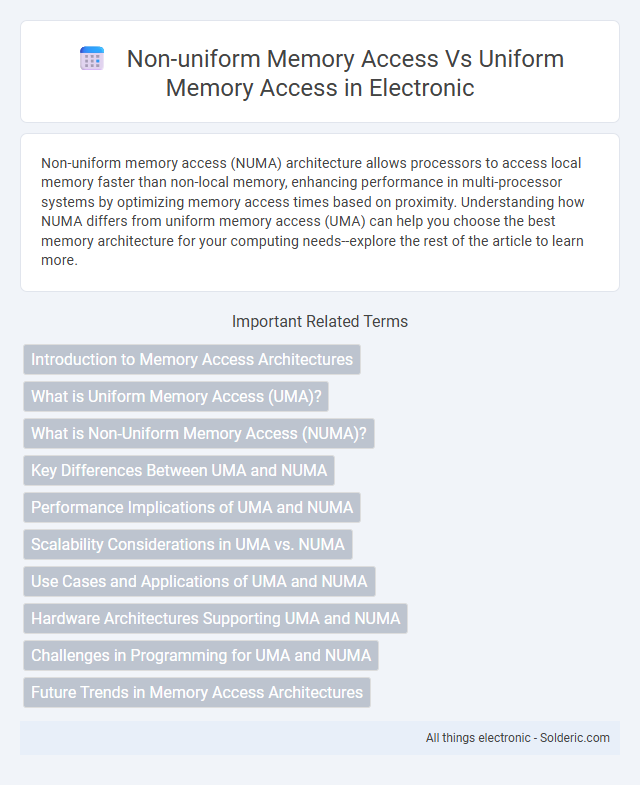Non-uniform memory access (NUMA) architecture allows processors to access local memory faster than non-local memory, enhancing performance in multi-processor systems by optimizing memory access times based on proximity. Understanding how NUMA differs from uniform memory access (UMA) can help you choose the best memory architecture for your computing needs--explore the rest of the article to learn more.
Comparison Table
| Feature | Non-Uniform Memory Access (NUMA) | Uniform Memory Access (UMA) |
|---|---|---|
| Memory Access Time | Varies depending on memory location relative to processor | Constant latency regardless of memory location |
| Architecture | Distributed memory architecture | Shared memory architecture |
| Scalability | High scalability, suitable for multi-processor systems | Limited scalability |
| Use Case | Multi-core servers, high-performance computing | Single or fewer processors, standard desktop systems |
| Complexity | More complex memory management and programming | Simpler memory management |
| Cost | Higher hardware and design cost | Lower cost implementation |
Introduction to Memory Access Architectures
Non-uniform memory access (NUMA) and uniform memory access (UMA) represent two distinct memory architectures used in multiprocessor systems to manage how processors access memory. UMA systems feature equal latency and bandwidth for all memory accesses regardless of the processor, ideal for smaller shared-memory configurations. NUMA architecture improves scalability by allowing processors to access local memory faster than remote memory, reducing bottlenecks in large-scale, multi-node environments.
What is Uniform Memory Access (UMA)?
Uniform Memory Access (UMA) refers to a computer memory architecture where all processors share the physical memory uniformly, meaning each processor has equal access time to any memory location. This design simplifies programming and improves predictability in performance because memory latency is consistent across the system. In contrast to Non-Uniform Memory Access (NUMA), UMA systems avoid complexities related to memory access times varying by location, which can affect your application's efficiency in multiprocessor environments.
What is Non-Uniform Memory Access (NUMA)?
Non-Uniform Memory Access (NUMA) is a computer memory design used in multiprocessor systems where memory access time depends on the memory location relative to a processor. In NUMA architectures, processors have faster access to their local memory compared to non-local memory, reducing latency and increasing efficiency for specific workloads. Understanding NUMA is crucial for optimizing your software and hardware configurations to achieve better performance in multi-core and multi-processor systems.
Key Differences Between UMA and NUMA
Uniform Memory Access (UMA) features equal memory access time for all processors, enabling straightforward system design but limiting scalability in multi-processor architectures. Non-Uniform Memory Access (NUMA) differentiates memory access times by processor location, optimizing performance through localized memory access while posing challenges in memory management. Your choice between UMA and NUMA directly impacts system efficiency, especially in high-performance computing environments where access latency and scalability are critical.
Performance Implications of UMA and NUMA
Non-Uniform Memory Access (NUMA) architectures offer improved scalability by allowing processors to access local memory faster than remote memory, reducing latency and increasing overall throughput in multi-processor systems. Uniform Memory Access (UMA) provides consistent memory access times across all processors, which simplifies programming but can create bottlenecks as the number of processors grows, limiting performance in large-scale systems. NUMA's performance benefits are most evident in workloads with high locality, while UMA performs reliably in smaller, shared-memory multiprocessing environments.
Scalability Considerations in UMA vs. NUMA
Non-uniform memory access (NUMA) architectures offer improved scalability over uniform memory access (UMA) by allowing processors to access local memory faster than remote memory, reducing latency and contention as the number of processors increases. In contrast, UMA systems face limitations in scalability due to a single shared memory architecture that causes bottlenecks and increased memory access times when multiple processors compete for the same memory resources. You should consider NUMA's architecture for high-performance computing environments where scalability and efficient memory access are critical.
Use Cases and Applications of UMA and NUMA
Uniform Memory Access (UMA) is commonly used in small-scale multiprocessor systems, where equal memory access time simplifies programming and is ideal for applications requiring consistent latency, such as real-time processing and scientific simulations. Non-Uniform Memory Access (NUMA) is suited for large-scale, high-performance computing environments where processors access local memory faster than remote memory, benefiting data-intensive applications like database management, virtualization, and big data analytics. Your choice between UMA and NUMA architectures impacts system performance and scalability based on workload memory access patterns.
Hardware Architectures Supporting UMA and NUMA
Hardware architectures supporting Uniform Memory Access (UMA) typically utilize symmetric multiprocessing (SMP) systems where all processors share a single, centralized memory with uniform latency and bandwidth. In contrast, Non-Uniform Memory Access (NUMA) architectures distribute memory across processors, creating multiple memory nodes that deliver faster access locally but slower access to remote memory, optimizing scalability for multi-processor systems. Understanding the underlying hardware design enables you to select the architecture best suited for workloads requiring consistent memory access times (UMA) or high scalability with localized memory access (NUMA).
Challenges in Programming for UMA and NUMA
Programming for Uniform Memory Access (UMA) systems often faces challenges related to memory bandwidth contention and latency uniformity, which can limit scalability in multi-core processors. Non-Uniform Memory Access (NUMA) introduces complexities in data locality and memory allocation, requiring programmers to optimize for latency disparities across memory nodes to prevent performance degradation. Efficient NUMA programming demands explicit handling of memory affinity and thread scheduling to minimize remote memory access penalties and maximize throughput.
Future Trends in Memory Access Architectures
Future trends in memory access architectures emphasize increased adoption of Non-Uniform Memory Access (NUMA) designs to optimize performance in multi-core and multi-processor systems, as they reduce latency by localizing memory access. Uniform Memory Access (UMA) remains relevant for simpler and smaller-scale systems, but evolving workloads demand more scalable and efficient memory hierarchies that NUMA supports. Your system's future performance improvements may rely heavily on the integration of hybrid memory models combining the benefits of both NUMA and UMA architectures.
Non-uniform memory access vs uniform memory access Infographic

 solderic.com
solderic.com